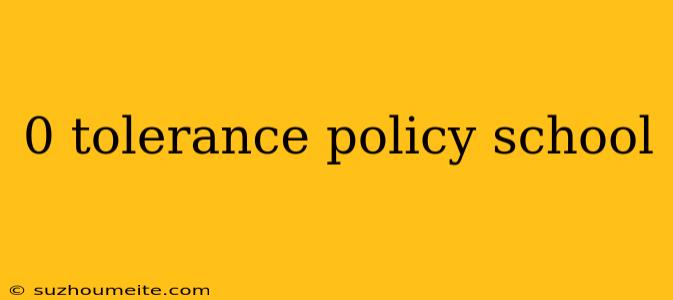Zero Tolerance Policy in Schools: Effective or Harmful?
Introduction
Zero tolerance policies in schools have been a topic of debate for many years. These policies aim to provide a safe and disciplined learning environment by imposing automatic penalties, usually expulsion, for students who engage in certain behaviors such as violence, drug possession, or weapon carrying. The goal is to create a zero-tolerance atmosphere, where students know that certain actions will not be tolerated and will result in severe consequences. However, critics argue that these policies can be overly harsh and ineffective in addressing the root causes of misbehavior.
The History of Zero Tolerance Policies
Zero tolerance policies in schools originated in the 1980s in the United States as a response to growing concerns about school violence and drug use. The policies were initially aimed at addressing the rise of gang violence and drug trafficking in schools. The 1994 Gun-Free Schools Act, which mandated that schools expel students who brought firearms to school, further solidified the zero tolerance approach.
The Proponents of Zero Tolerance Policies
Supporters of zero tolerance policies argue that they:
- Deter Misbehavior: By imposing severe penalties, students are less likely to engage in misbehavior, as they know the consequences will be severe.
- Create a Safe Learning Environment: By removing students who engage in disruptive or dangerous behavior, schools can provide a safer environment for other students to learn.
- Send a Strong Message: Zero tolerance policies send a clear message to students that certain behaviors will not be tolerated, which can help to reduce misbehavior.
The Critics of Zero Tolerance Policies
Critics of zero tolerance policies argue that they:
- Are Overly Harsh: Automatic penalties, such as expulsion, can be overly harsh and may not take into account the context or circumstances of the incident.
- Do Not Address the Root Causes of Misbehavior: Zero tolerance policies do not address the underlying reasons for misbehavior, such as poverty, lack of support, or mental health issues.
- Disproportionately Affect Certain Groups: Research has shown that zero tolerance policies can disproportionately affect certain groups, such as students of color, students with disabilities, and LGBTQ+ students.
Alternatives to Zero Tolerance Policies
Some schools have begun to move away from zero tolerance policies and instead adopt alternative approaches, such as:
- Restorative Justice: This approach focuses on repairing harm and building relationships, rather than punishing students.
- Positive Behavioral Interventions and Supports (PBIS): This approach focuses on creating a positive school climate and providing support to students, rather than relying on punishment.
Conclusion
Zero tolerance policies in schools are a complex and controversial issue. While they aim to provide a safe and disciplined learning environment, critics argue that they can be overly harsh and ineffective in addressing the root causes of misbehavior. Alternative approaches, such as restorative justice and PBIS, offer a more holistic and supportive approach to addressing misbehavior. Ultimately, the goal of school policies should be to provide a safe and supportive environment that allows all students to thrive.
